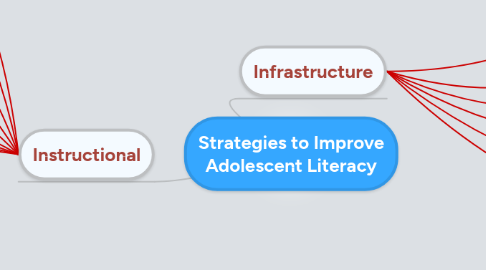
1. Instructional
2. Collaboration
2.1. Students must work with each other and the text - help further each other's understanding
2.1.1. Group Discussion
2.1.2. Projects
3. Comprehension
3.1. Model to students what a good reader looks/sounds like
3.1.1. Questioning the author
3.1.2. Summarizing text
3.1.3. Keeping track of your understanding
4. Practice
4.1. Students need time in text in many different ways - different classrooms, subjects, texts
5. Motivation
5.1. Starts in the classroom with the teacher as the source then continues in regular life (post-high school)
5.1.1. Teachers must be in tune to students interests
5.1.1.1. I took Adolescent Literature with Beth Younger at Drake a few semesters ago and I learned the importance of including young adult novels in an English class. If you find books they can relate to (but that still fulfill your goals) they are more likely to engage and enjoy the class
5.1.2. Strategic Instruction Model - Visual Imagery Strategy
5.1.2.1. At the end of AP Literature senior year, we had an extra credit final project in which students would form groups then create a movie in which they acted out scenes from one of the novels we read; or a summary video of the novel. It was a creative, fun way for the students to connect back to what they read.
6. One-on-one
6.1. Intense individualized learning
6.1.1. Not only with the teacher but some form of tutoring
6.1.1.1. In my high school we had a tutoring center. Teachers would nominate students they thought were proficient enough to tutor in certain subjects. I was recommended for english and math. Our peers would then come in during their free period and we would help them with homework, projects, editing papers etc.
6.1.1.2. "Finally, such a center might organize the training of adolescents as tutors for younger struggling readers. There is again good evidence that adolescent struggling readers benefit from tutoring younger struggling readers (and the young readers benefit also)" (202)
6.1.1.2.1. We also had a program where we would go and read to preschool students. It was for National Honor Society but after reading this article, I could see how this activity would benefit struggling readers as well.
7. Diverse texts
7.1. Diverse topics
7.2. Diverse authors
7.3. Diverse writing styles
8. Writing
8.1. Not only about literature but "outside school" writing as well
9. Technology
9.1. Tool of instruction
10. Assessment
10.1. Ongoing throughout schooling
11. Infrastructure
12. More time for reading
12.1. Silent reading
12.1.1. "Ivey, Smith and Wilhelm and Worthy and McCool report huge gaps between what adolescents report they like to read and what is available in middle and high school libraries and classrooms (199)
12.1.1.1. My high school had a list of books that students would choose from for our summer reading. When school started we would all meet with our book group and have a discussion. This selection could be provided during the school year as well.
12.1.2. "...teachers almost always assigned reading materials, and rarely was there time set aside in school for independent reading" (199)
12.1.2.1. In middle school we had bingo sheets that we would choose books from to read and when we got a bingo we would get a prize or something (I don't exactly remember). Each square was a different book and we had to complete a different project or book report for each one.
